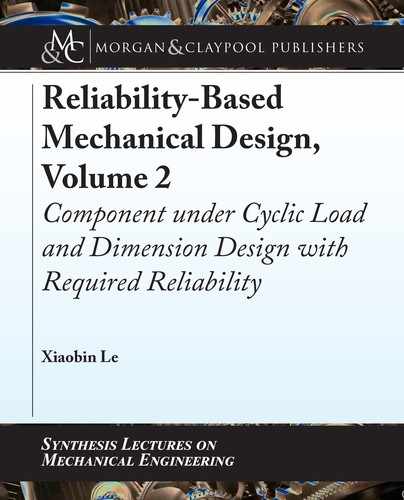
xv
Preface
Reliability-Based Mechanical Design consists of two separate books: Volume 1: Component under
Static Load and Volume 2: Component under Cyclic Load and Dimension Design with Required
Reliability.
Volume 1 consists of four chapters and Appendix A. ey are:
• Chapter 1: Introduction to Reliability in Mechanical Design;
• Chapter 2: Fundamental Reliability Mathematics;
• Chapter 3: Computational Methods for the Reliability of a Component;
• Chapter 4: Reliability of a Component under Static load; and
• Appendix A: Samples of MATLAB Programs.
Volume 2 consists of three chapters and two appendixes. ey are:
• Chapter 1: Introduction and Cyclic Loading Spectrum;
• Chapter 2: Reliability of a Component under Cyclic Load;
• Chapter 3: e Dimension of a Component with Required Reliability;
• Appendix A: ree Computational Methods for the Reliability of a Component; and
• Appendix B: Samples of MATLAB Programs.
e first book discusses fundamental concepts for implementing reliability in mechanical
design and the reliability of a component under static load. e second book presents more
advanced topics, including the reliability of a component under cyclic load and the dimension
design with required reliability.
is is Reliability-based Mechanical Design, Volume 2: Component under Cyclic Load and
Dimension Design with Required Reliability. It is recommended that Volume 1 should be read
first before Volume 2 because it provides fundamental concepts and computational methods for
implementing reliability in mechanical design and the reliability of a component under static
load.
is book presents how to determine reliability, and quantitively predict the failure per-
centage of a component under cyclic load. is book also presents how to design component
dimension with required reliability for a component under static load or cyclic load. erefore,
xvi PREFACE
the component will be reliable during its service under the specified load because it has been
designed with required reliability.
is book is based on the author’s recent research and a series of lecture notes of an elective
course for senior mechanical students. is book is written as a textbook for senior mechanical
students. Every topic is discussed in sufficient detail and demonstrated by many examples so
that students or design engineers can readily use them in mechanical design. At the end of each
chapter, there is a wide selection of exercise. is book can also be used for a graduate student
course and a reference book for design engineers.
is book consists of three chapters and two appendixes. A concise summary of each
chapter are as follows.
• Chapter 1: Introduction and Cyclic Load Spectrum
is chapter presents a systematic description of a cyclic load. Six models of cyclic loading
spectrum will be presented and can be used to describe any type of cyclic load.
• Chapter 2: Reliability of a Component under a Cyclic Load
is chapter describes how to establish the limit state function of a component under a
cyclic load, and then how to determine the reliability of a component under such cyclic
load. e book presents two fatigue theories to calculate the reliability of a component
under cyclic load. e first theory is the P-S-N (Probailitis-Stress-Number of cycles) curve
approach. e second theory is the probabilistic fatigue damage model (the K-D model).
Five typical component cases under cyclic load presented in this chapter include bar under
cyclic axial load, pin under cyclic direct shearing, shaft under cyclic torsion, beam under
cyclic bending, and a rotating shaft under cyclic combined loads.
• Chapter 3: e Dimension of a Component with Required Reliability
is chapter presents how to design the dimension of a component with required reliability
under static load or cyclic load. For the dimension of a component under cyclic load, the
second fatigue theory, that is, the K-D model is mainly used. Five typical component
dimension design with required reliability presented in this chapter include bar under axial
load or cyclic axial load, pin under direct shearing or cyclic direct shearing, shaft under
torsion or cyclic torsion, beam under bending or cyclic bending, and a component under
combined loads or cyclic combined loads.
• Appendix A: Computational Methods for Calculating the Reliability of a Component
Appendix A concisely describes the procedures of the Hasoder-Lind (H-L) method, the
Rachwitz-Fiessler (R-F) method, and the Monte Carlo method for calculating the reliabil-
ity of a component, which has been presented in details in the first book: Reliability-based
Mechanical Design, Volume 1: Component under Static Load.
• Appendix B: Samples of six MATLAB Programs
PREFACE xvii
Appendix B provides six MATLAB program as a reference, including three programs
for the calculation of reliability and another three programs for dimension design with
required reliability.
is book could not have been completed and published without lots of encouragement
and help. First, I sincerely thank Mechanical Department Chairman and Professor Mickael
Jackson at the Wentworth Institute of Technology, whose encouragement motivated me to open
two technical elective courses about the reliability in mechanical engineering. Second, I sincerely
thank Professors Anthony William Duva and Richard L. Roberts for reviewing some of the
manuscripts. ird, I sincerely thank Morgan & Claypool Publishers and Executive Editor Paul
Petralia for helping with this publication. Finally, I sincerely thank my lovely wife, Suyan Zou.
Without her support, I could not have completed this book.
Xiaobin Le
October 2019
..................Content has been hidden....................
You can't read the all page of ebook, please click here login for view all page.
